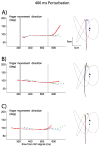Following and intercepting scribbles: interactions between eye and hand control
- PMID: 23552996
- PMCID: PMC3661774
- DOI: 10.1007/s00221-013-3496-2
Following and intercepting scribbles: interactions between eye and hand control
Abstract
The smooth pursuit eye movement system appears to be importantly engaged during the planning and execution of interceptive hand movements. The present study sought to probe the interaction between eye and hand control systems by examining their responses during an interception task that included target speed perturbations. On 2/3 of trials, the target increased or decreased speed at various times, ranging from about 300 ms before to 150 ms after the onset of a finger movement directed to intercept the target and was triggered by a GO signal. Additionally, the same 2D sum-of-sines target trajectories were followed with the eyes without interception. The smooth pursuit system responded more quickly if the target speed perturbation occurred earlier during the reaction time (i.e., near the time of the GO signal). Similarly, the finger movement began more quickly if target speed was increased earlier during the reaction time. For early perturbation conditions, the initial direction of the finger movement matched the predicted target intercept using the new target speed. For perturbations occurring after finger movement, onset initial direction of finger movement did not match target interception such that the finger path began to curve toward the perturbed target after about 150-200 ms. The results support the idea of an active process of visual target path extrapolation simultaneously used to guide both the eye and hand.
Figures






References
-
- Batista AP, Buneo CA, Snyder LH, Andersen RA. Reach plans in eye-centered coordinates. Science. 1999;285:257–260. - PubMed
-
- Bell AH, Meredith MA, Van Opstal AJ, Munoz DP. Stimulus intensity modifies saccadic reaction time and visual response latency in the superior colliculus. Experimental Brain Research. 2006;174:51–59. - PubMed
-
- Brenner E, Smeets JBJ. Fast responses of the human hand to change in target position. Journal of Motor Behavior. 1997;29:297–310. - PubMed
-
- Brenner E, Smeets JBJ, de Lussanet MHE. Hitting moving targets continuous control of the acceleration of the hand on the basis of the target’s velocity. Experimental Brain Research. 1998;122:467–474. - PubMed
Publication types
MeSH terms
Grants and funding
LinkOut - more resources
Full Text Sources
Other Literature Sources

